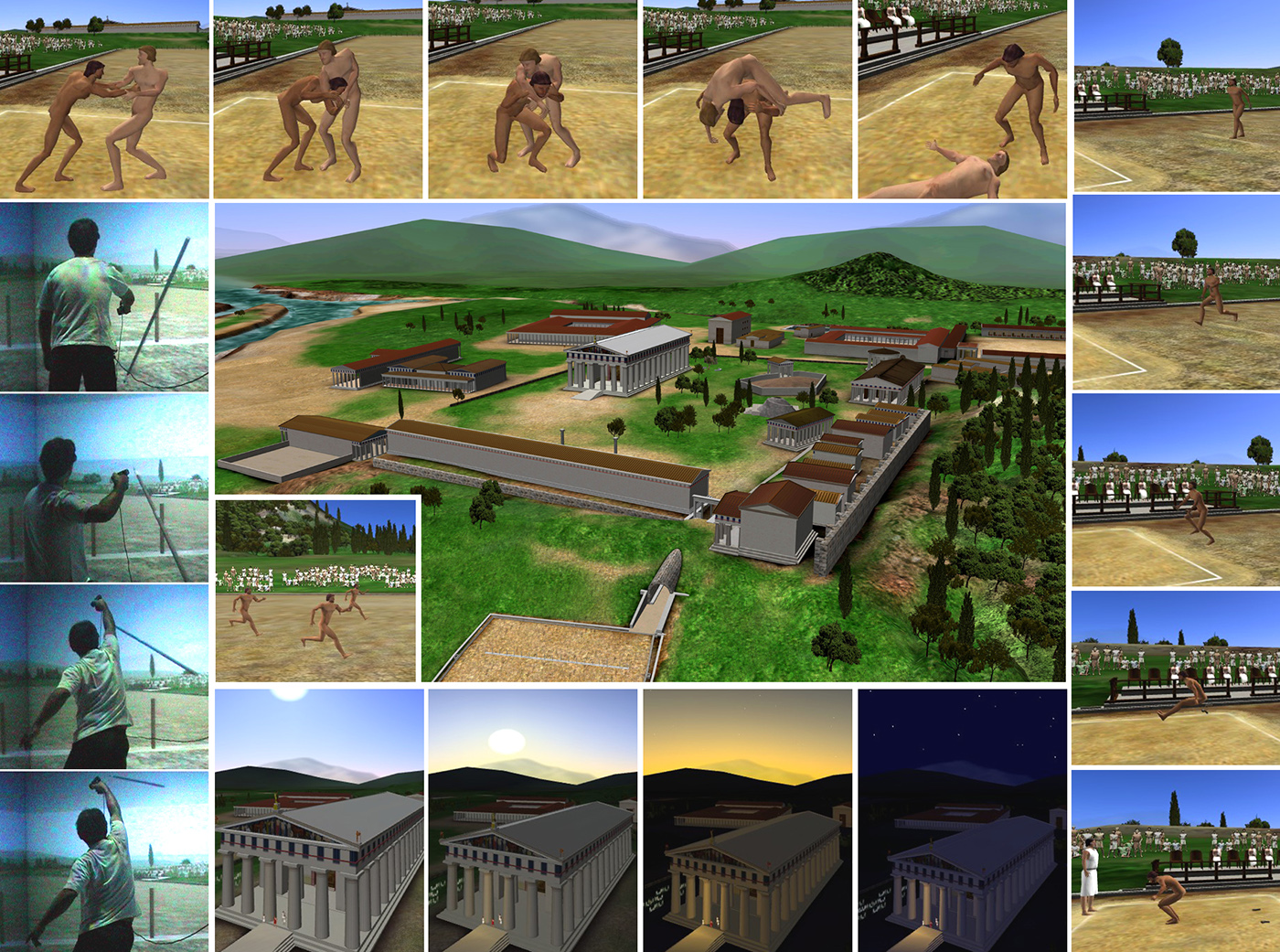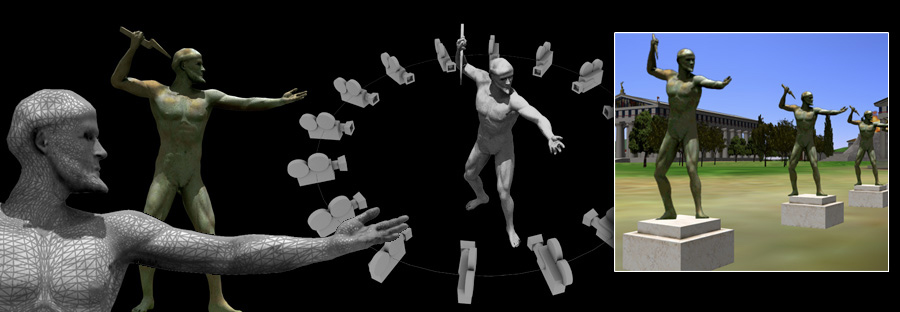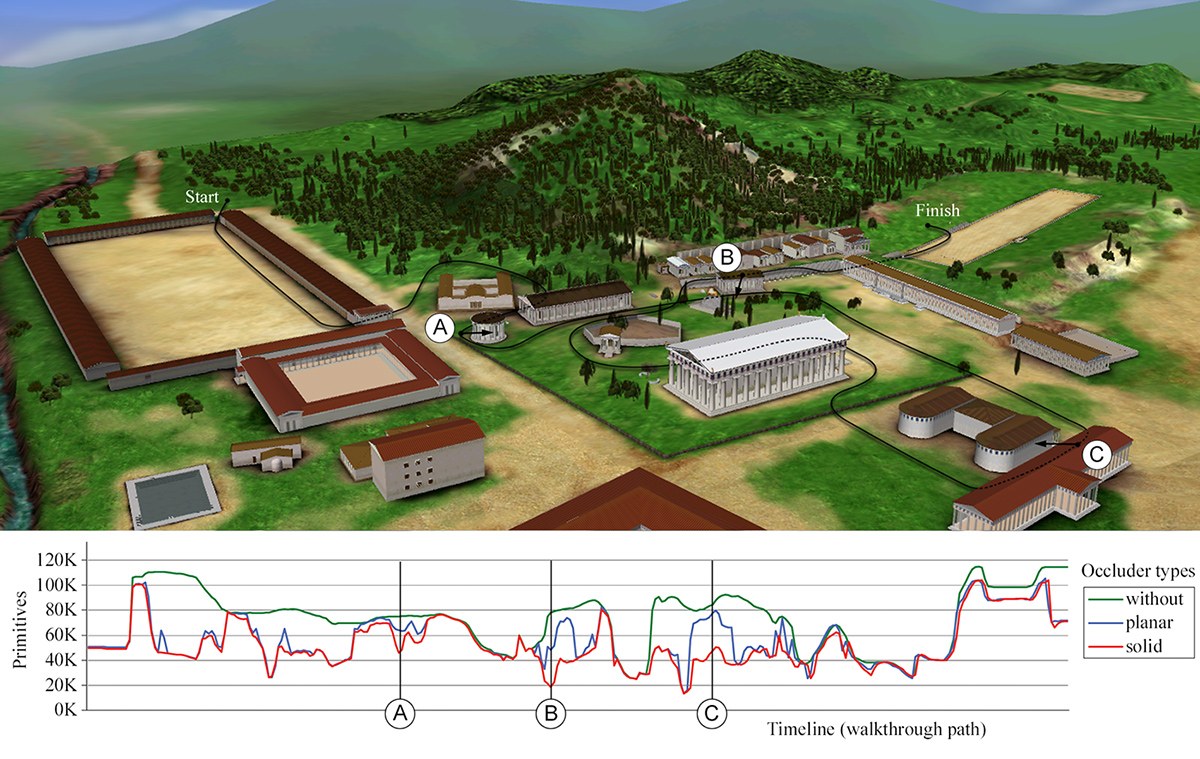A Walk through Ancient Olympia
2003-2006, Foundation of the Hellenic World
-
Introduction

Screenshots and live capture from the production "A Walk through Ancient Olympia". The undertaking of the 28th Summer Olympiad by Athens, the capital city of Greece, has spurred an increased interest for shows and complementary edutainment contributions to the games themselves. The Foundation of the Hellenic World (FHW) has prepared a series of thematic productions related to ancient Olympia and the Olympic Games, culminating with the highly interactive and accurate representation of ancient Olympia and the pentathlon (running, long jump, javelin, discus throwing and wrestling), whose final version was released just before the beginning of the Olympic Games. The high demand for interactive and entertaining productions, apart from simple walkthrough applications, however eye-catching, has driven the virtual reality team of the FHW to pursue a role-playing active interaction model different from the classic navigator/inspector one. In the VR production "A Walk through Ancient Olympia", the user, apart from visiting the historical site, learns about the ancient games themselves by interacting with athletes in the ancient game of pentathlon.
-
Storyline
(excerpt from "The Ancient Olympic Games: Being Part of the Experience")
We are at the end of the 2nd century BC. The day breaks and in front of us appears the majestic sanctuary of Zeus in Ancient Olympia. In antiquity the Olympic Games took place here, while today it hosts the lighting of the Olympic flame. The visitors can wonder around and visit the buildings and learn their history and their function: the Heraion, the oldest monumental building of the sanctuary dedicated to the goddess Hera, the temple of Zeus, a model of a Doric peripteral temple with magnificent sculpted decoration, the Gymnasium, which was used for the training of javelin throwers, discus throwers and runners, the Palaestra, where the wrestlers, jumpers and boxers trained, the Leonidaion, which was where the official guests stayed, the Bouleuterion, where athletes, relatives and judges took a vow that they would upheld the rules of the Games, the Treasuries of various cities, where valuable offerings were kept, the Philippeion, which was dedicated by Philip II, king of Macedonia, after his victory in the battle of Chaeronea in 338 BC and the Stadium, where most of the events took place.
In addition, the public can interact virtually with 3D digital representations of Olympian athletes in the ancient pentathlon, including the 200-meter sprint, the discus throwing, the long jump, the javelin throwing and wrestling. Instead of just observing the games the visitors take place in them. They pick up the discus or the javelin and they try their abilities in throwing them towards the far end of the stadium. Excited about the interaction they ask when will they be able to interact with the wrestler one on one. A role-playing model of interaction with alternating roles was tried here with pretty good success as the visitors truly immersed in the environment wish they could participate in more games.
Finally, decorated with red ribbons in his hands and legs, the glorious winner makes the tour of triumph holding a palm leaf in his hand while the spectators give him a standing ovation. The Games come to an end..
-
Image-based rendering
Throughout the production, image-based rendering (IBR) was extensively used not only to model flora, but also for complex and expensive geometry such as distant people and high-detail statues.

The figure shows the statue of Zeus, modeled in 3D Studio MAX and rendered using multi-view IBR. Later, the IBR statue was replaced with actual geometry, as the upgraded hardware would allow a higher polygon budget. -
Efficient occlusion culling
Another problem that we came across when deploying the production on the SGI Onyx-driven CAVE, was that performance was really coming down to a crawl at certain locations, due to heavy overdraw. This is when we had to investigate a solution with regard to occlusion culling. Existing methods mostly relied on the concept of portals or planar occluders. Unfortunately, for an open environment such as Ancient Olympia, most algorithms either failed to provide adequate culling or performed well but with a significant performance hit, thus countering the benefits of occlusion culling.
In occlusion culling, geometry that is hidden behind objects closer to the camera point is discarded before being subject to depth sorting algorithms, although this geometry may pass the other two culling tests. Most occlusion culling methods use planar occluders and their projections on the viewing plane. These planar occluders are often the polygons of the blocking geometry. An extension to the popular shadow frustum culling algorithm has been investigated, which takes into account the fact that many planar occluders can be grouped into compound convex solids, which in turn can provide fewer and larger culling frusta and therefore more efficient elimination of hidden geometry. This approach provides better occlusion at a significantly reduced cost due to fewer occlusion tests. The figure below demonstrates the principle of the solid occluders method (G. Papaioannou, A. Gaitatzes, D. Christopoulos, Efficient Occlusion Culling using Solid Occluders. Proceedings of the 14-th International Conference in Central Europe on Computer Graphics, Visualization and Computer Vision (WSCG), 2006).


Using solid occluders to more efficiently cull geometry. -
Lightweight dynamics system
One of the challenges in the "Walk through Ancient Olympia" was to be able to actively participate in at least one of the games. Considering the difficulty to move in a CAVE when surrounded by spectators, we decided to implement such interaction for the discus and javelin throwing games, which are relatively static. Both games required that the user take hold of an object and send it flying through the scene under the influence of forces in a controllable manner. The object would collide, bounce off and exchange energy with other geometry. For this purpose we used a custom implementation of Newtonian dynamics, a well-known and extensively studied motion model for rigid bodies and their response to collisions, rather an off-the-shelf solution, due to very limited computational resources
In the VR software implementation, special geometric nodes, the dynamics objects, can be “hooked” to or “unhooked” from force fields at run-time. These objects govern their motion themselves under the influence of the forces they are presently attached to, unless they take part in one or more dynamic simulations. In the second case, the simulation node reports collisions, manages friction and dumping constraints, calculates the exchange of energy between objects (not necessarily all dynamic) participating in the simulation and estimates new linear and rotational speed and momentum for the objects. For the moment, dynamic objects are controlled only by one hard constraint vital to our applications: grabbing. Once a dynamic object is grabbed, the differential rotational part of the user’s hand (wand) transformation is applied at each frame to the dynamic object first. The force-related differential matrix is then applied and finally, the positional part of the wand motion. In this order, the trajectory defined by the current forces and the wand influence are disassociated. Various types of force fields were supported, including wand-controlled and transformable ones. The actual throwing action uses a wand-controlled force field (duration of application and direction), combined with a conventional linear field for the gravity.

